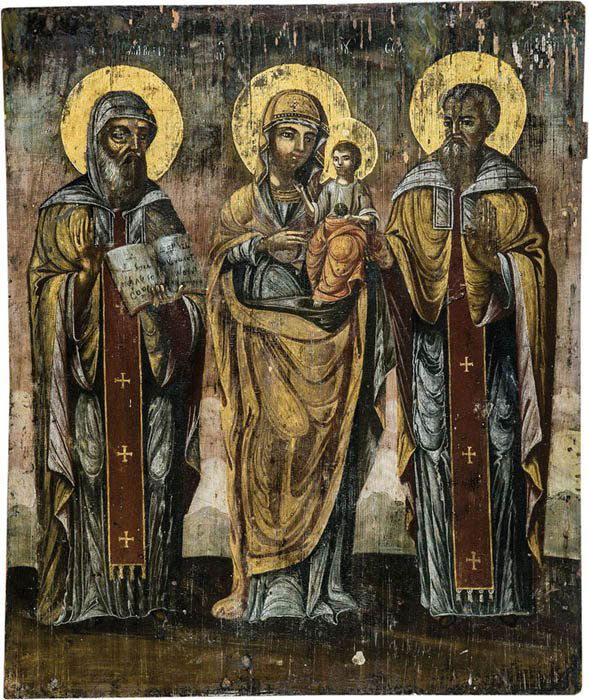
Large-sized icon with the Virgin Hodegetria Romania, circa 1800 Softwood single board with two back side Sponki. Tempera on gesso. Full-length depiction of the Virgin Mary carrying the Christ child in her left arm. Christ holding a globe in his left hand. They are flanked by two monks blessing them, including St. login. 53 x 44 cm
Wooden Icons were likely to warp. Slats inserted in the back to prevent warping, and that name is SHPONKI. One usually finds two SHPONKI, one coming in from either side toward the center, but occasionally just one SHPONKA
Gesso, from the Latin gypsum, is a white paint mixture consisting of a binder mixed with chalk, gypsum, pigment...
A Hodegetria (literally: "She who shows the Way"; or Virgin Hodegetria, is an iconographic depiction of the Theotokos (Virgin Mary) holding the Child Jesus at her side while pointing to Him as the source of salvation for mankind. In the Western Church this type of icon is sometimes called Our Lady of the Way.
The most venerated icon of the Hodegetria type, regarded as the original, was displayed in the Monastery of the Panaghia Hodegetria in Constantinople, which was built specially to contain it. Unlike most later copies it showed the Theotokos standing full-length. It was said to have been brought back from the Holy Land by Eudocia, the Empress of Theodosius II (408–450), and to have been painted by Saint Luke. The icon was double-sided, with a crucifixion on the other side, and was "perhaps the most prominent cult object in Byzantium".
The original icon has probably now been lost, although various traditions claim that it was carried to Russia or Italy. There are a great number of copies of the image, including many of the most venerated of Russian icons, which have themselves acquired their own status and tradition of copying.
Luke the Evangelist is one of the Four Evangelists/authors of canonical Gospels of Jesus Christ. Luke was a native of the Hellenistic city of Antioch in Syria. The early church fathers ascribed to him authorship of both the Gospel according to Luke and the book of Acts of the Apostles, which originally formed a single literary work, referred to as Luke–Acts.
The New Testament mentions Luke briefly a few times, and the Pauline epistle to the Colossians refers to him as a doctor; thus he is thought to have been both a physician and a disciple of Paul. Christians since the faith's early years have regarded him as a saint. He is believed to have died a martyr, although accounts of the events do vary.
The Roman Catholic Church and other major denominations venerate him as Saint Luke the Evangelist and as a patron saint of artists, physicians, surgeons, students and butchers. More
St. login: I could not find any information about this Saint!
Aelia Eudocia Augusta] (c. 401–460) was the wife of Theodosius II, and a prominent historical figure in understanding the rise of Christianity during the beginning of the Byzantine Empire. Eudocia lived in a world where Greek paganism and Christianity were existing side by side with both pagans and unorthodox Christians being persecuted.[1] Although Eudocia's work has been mostly ignored by modern scholars, her poetry and literary work are great examples of how her Christian faith and Greek upbringing were intertwined, exemplifying a legacy that the Byzantine Empire left behind on the Christian world. More
No comments:
Post a Comment